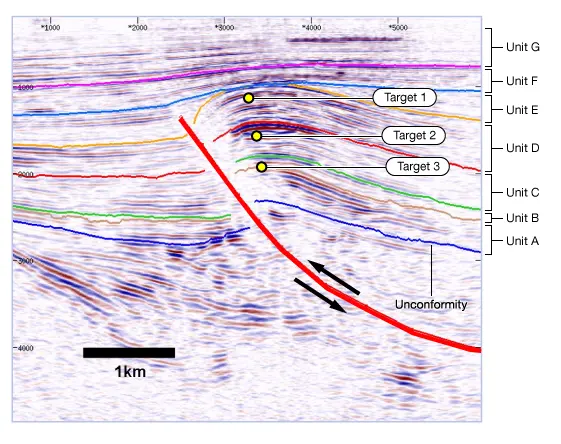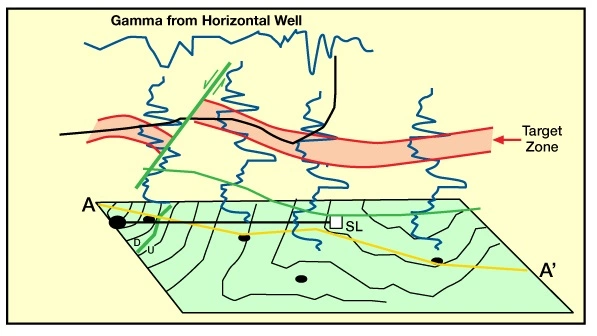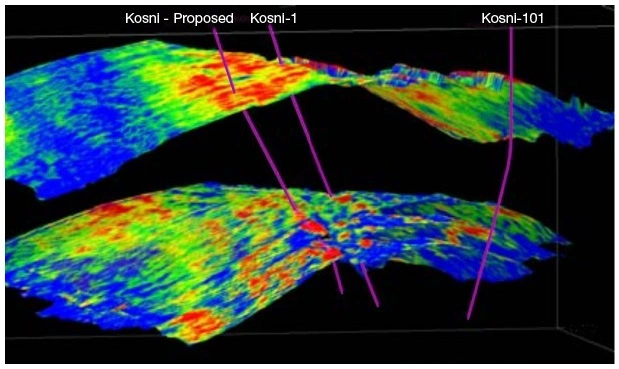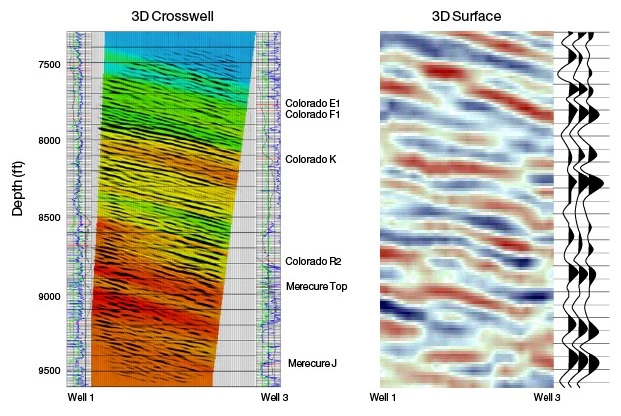Assignment Petroleum Geophysics
Exploration in a New Basin
You are assisting an exploration team to identify a potential working hydrocarbon system in a new basin. Your first step is to determine if the elements needed for a hydrocarbon system are present. Some interpretation has already been performed. Possible rock types have also been assigned based on information from neighboring basins.
Use the following provided data to complete your exploration task.
Part A:
Basin assumptions include:
- Unit A is an organic marine shale.
- Units B and C are high-porosity and high-permeability sandstones.
- Unit D is shale at the base and grades into a high porosity and high permeability sandstone.
- Unit E is a moderately organic marine shale.
- The blue surface itself represents unconformity.
- Unit F is a clay-rich siltstone.
- Unit G above the pink surface is moderately organic marine shale.
- The fault is a sealing fault.

Based on these assumptions, are the elements needed in a hydrocarbon system present?
Solution
The elements needed in a hydrocarbon are present.
These elements include:
- Source: unit A is a highly organic marine shale.
- Reservoir: units B, C, and D are good candidates.
- Trap: the fault is a sealing fault—acts as a trap—and there is the anticline.
- Seal: there is the fault and there are also the shales of units E and F, and the shale within unit D.
- Migration Path: from unit A (source) into units B, C, and D (reservoirs).
Part B:
You have determined that the hydrocarbon elements are present in the new basin. Your next task is to drill the first exploratory well.
According to the following image, if given a choice, where would you target the first well? Remember to think about the risks and uncertainties associated with each.

Solution
Target 2 the top of Unit C would be the optimal choice for drilling an exploration well.
In target 2:
- The target is within the anticline.
- There is shale in the base of unit D that could act as a seal.
- The fault is a sealing fault, indicating the likelihood of hydrocarbons migrating out is low.
Migration from the source of unit A has a likely path through unit B and into unit C.
Assessment Petroleum Geophysics
1. Historically, seismic data was recorded in the field on __________.
A .traces
B .tapes
C .geophones
D .logs
2. Which geologic features are typically a type of trap? (Select all that apply.)
A .Salt dome
B .Pinch-out
C .Unconformity
D .Anticline fault
E .Lava flow
3. Many field geophysicists have a __ in geophysics or geology.
A .Master’s degree
B .Bachelor’s degree
C .PhD degree
D .High school diploma
4. During acquisition operations, seismic data is collectively gathered in ________.
A .geophones
B .recorder trucks
C .vibrator trucks
D .data tapes
5. What source rock seal parameter cannot be detected by geophysical methods?
A .Conditions of deposition
B .Rock volume
C .Original organic content
D .Rock type
E .Temperature and burial history
Recommended for You
Introduction to Seismic Interpretation
Interpretation with Seismic Attributes
 Petro Shine The Place for Oil and Gas Professionals.
Petro Shine The Place for Oil and Gas Professionals.



